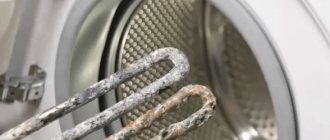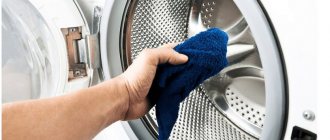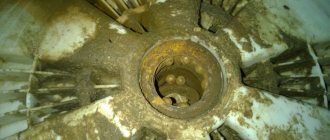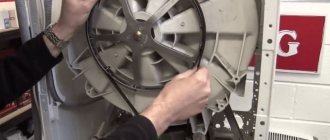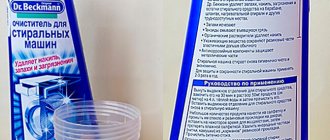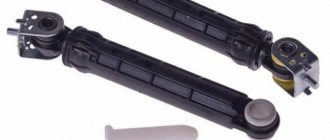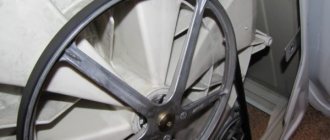Modern washing machines equipped with program control have many advantages compared to semi-automatic devices.
Regardless of what model of device you own, the problem of the negative impact of hard water on unit parts remains relevant.
How to clean the drum
- Pour 100 ml of chlorine bleach into the machine drum and start the wash at a temperature of at least 60 °C. Without underwear, of course.
- You can use citric acid to remove scale. Pour 100 g into the drum and run the wash at maximum temperature. Ideally, the mode will include double rinsing. Then the plaque will be removed 100%.
- Mix a small amount of water and soda in a 1:1 ratio and pour the solution into the detergent compartment. Pour a little vinegar into the drum itself: no more than 400 ml. Set the temperature to maximum and let the machine do almost all the work for you. Then remove any remaining dirt with a sponge and wipe the drum dry. Plaque, mold and unpleasant odor will disappear without a trace.
Why is cleaning required?
Daily washing leads to the fact that a greasy coating settles on the surface of the drum, which is then difficult to remove. Ultimately, the mechanism can quickly break down. If you clean the drum in your washing machine on a regular basis, this will significantly extend its life.
Using this process, it becomes possible to remove insoluble particles that settle on the plastic surface of the tank during daily use of the device. These can be particles such as:
- fabric fibers;
- sand;
- hair;
- villi;
- threads
To prevent equipment breakdown and not to call a repairman, it is better to check the items loaded there before each use. It is important to ensure that foreign objects do not get in. It is generally better to load delicate laundry into a specially designed bag.
Contaminated water that appears during washing can cause the resulting metal salts to settle inside the appliance.
How to descale heating elements
- Citric acid will again help get rid of scale on the electric heater. The amount of powder depends on the degree of soiling, but on average, a machine with a 5 kg load requires 250 g. Pour 200 g into the powder compartment, and 50 into the drum and run the wash at maximum temperature.
- More aggressive acetic acid can also deal with scale. Just add 50 ml of vinegar to the conditioner container and turn on the machine. Be careful: vinegar can damage the rubber elements.
Causes of pollution and their possible consequences
First, let’s make sure that cleaning is a forced and necessary action. And it doesn’t hurt to know what exactly needs to be cleaned. Let's take a look inside the machine, which has worked for quite a long time. It is highly likely that we will see a dirty coating on the surface of plastic and metal parts. It can be hard and contain minerals, so you can’t handle it with a rag or your hands.
The reasons for this problem may be the following:
The water coming from the tap is hard or dirty.
The powder contains too many chemical components.
The machine constantly operates in the “intensive wash” mode.
What’s especially bad is that many of the corners where dirt accumulates are difficult to reach. Try to clean them - your hand won’t fit there, and poking with something sharp is too dangerous. So more and more dirt accumulates, and then the machine can’t stand it and breaks down. And repairs cost a pretty penny. So why go to such extremes - it’s better to ask in advance how to clean the drum of the washing machine, its tank and heating element. By taking timely measures, you can significantly extend the life of the device.
Why does scale form?
When water is too hard, it is full of calcium and magnesium salts. When heated, they are converted into carbon dioxide and solid sediment, which, together with dirty particles (for example, pieces of rust), remains on the heating element and the tank of the washing machine. When covered with a crust of scale, the metal heating element conducts heat worse. Result: water takes longer to heat up, more electricity is required. And dirt from the water also does its dirty work - it clogs the inlet valve, the parts of which wear out ahead of time.
Important: maximum dirt and debris penetrates into the machine after repairs or turning off the water.
You can find out whether there is scale on the heating element or not yourself. Usually the heating element is located directly under the drum, or is slightly offset relative to its center to one side. Taking a flashlight, direct its beam at the holes in the drum, trying to see the heating element. At the same time, shake the drum slightly so that the lighting is uniform. Often this is not possible right away - you have to experiment a little with the speed of swinging.
Washing machine heating element with huge salt deposits.
How to Clean a Drain Hose
When you clean the drum with baking soda and vinegar, the drain hose is also cleaned. But if a serious blockage occurs, additional measures must be taken.
Unplug the washing machine and turn off the water supply. Disconnect the hose from the machine (water may spill out during the process, so do not forget to substitute a container).
Now you can start cleaning. For it they use a Kevlar cable with a non-metallic (!) brush at the end. First clean the hose on one side, then the other, and finally rinse it under running hot water.
Cleaning the heating element and drum
The electric heater, which is constantly in contact with running water, occupies not the last place in the device of the washing machine. Therefore, it is important to regularly remove salts accumulated on it. How to remove scale from heating elements and drums? Below are the main methods that have long been proven by housewives.
Citric acid, vinegar, soda and bleach will help you clean your washing machine at home. After all, scale is calcium and magnesium salts, which are destroyed in an acidic environment.
Option 1: using improvised means
Here are a few ways to clean your washing machine with products you can find around the house:
- Pour lemon into the powder compartment and run some high-temperature mode. To know how much acidic powder to add, pay attention to the drum capacity and the degree of contamination. As a rule, 30 grams of acid per kilogram of load is taken.
- Use table vinegar. Pour a glass of 9% vinegar solution into the powder container, select washing at 90°C with soaking. You can then remove the smell from the drum with an additional rinse.
- You can prepare a solution. Mix half a glass of soda with half a glass of water and pour into the product compartment. Pour a glass of 9% acetic acid into the drum.
- Using bleach, substances containing chlorine.
On the Internet you can find other life hacks on how to clean your washing machine from scale and dirt. For example, pour five liters of Coca-Cola into a drum and leave for several hours. However, such methods are questionable; it is better to use time-tested methods.
You should not combine cleaning the machine and washing clothes. After the procedure, check the drain hose and drum cuff, remove scale particles.
It is good if there is a softening filter in the drain. But if it is missing, add Calgon to the powder - a special product for preventing contamination.
Water softener Calgon 500g
Option 2: chemical means
Cleaning washing machine parts using special chemicals has an advantage over traditional methods. Manufacturers develop the composition of such products taking into account the design features of the equipment, as well as safety for human health.
Study the composition of the product before purchasing. There are universal chemicals for cleaning the entire machine, and there is one that is intended only for removing mold and plaque.
Here is a list of the best anti-scale products for washing machines:
- Sano Antikalk Scale Remover . Made in Israel. Removes lime deposits from heating elements, drums, and housings. Does not contain harmful components. Also suitable for dishwashers. Extends the life of home aids and prevents rust.
- Tiret - cleaner for washing machines (Russia). Removes scale, detergent residues and other contaminants.
- Topperr 3004 . A German product recommended by the manufacturer Bosch. Effectively removes scale and is suitable for dishwashers.
- Magic Power . Made in Germany. It comes in powder and gel form and fights dirt on an electric heater or drum.
- Doctor TEN and Antinakipin are Russian and Belarusian manufacturers, respectively. They only remove scale, but are used to clean any equipment.
Washing machine care products
Be sure to read the description of the chemical product before purchasing and using. Many advertised substances (for example, Calgon) promise to protect your washing machine from scale, but do not help get rid of existing scale. They only reduce the amount of salts in running water. The difference between such preparations is significant - they are added during washing to the machine before starting, with powder or into the drum.
Option 3: Manually
Inspecting the electric heater is the first thing to do if you decide to clean the elements of the washing machine yourself. A thick layer of limestone is sometimes easier to remove by hand.
There is no need to use sharp objects for cleaning. There is a risk of damage to the coating of the heating element or its breakage. Place the element in citric acid diluted in water or in a solution with a special liquid.
Steps to manually clean an electric heater:
- First you need to disconnect the wires and sensor and remove the heating element.
- Then rinse the device with hot water to remove dirt and deposits.
- Place the element in a specially diluted solution to remove the remaining stone. You can take a plastic bottle with the neck cut off. Pour four tablespoons of lemon into it, place a heater in the bottle, and fill it with hot water.
- Shake the solution. How to understand that the process of dissolving salts has begun? Air bubbles will rise.
Let the heating element sit in the solution overnight. Then rinse it under water with a sponge and place it in the washing machine.
The electric heater is always located under the tank. However, depending on the brand of equipment, removing the element requires removing either the front panel or the back panel.
How to Clean a Top Loading Washing Machine
Cleaning is carried out at the highest temperature. First, pour 2-3 cups of vinegar into the water and let the machine stir the solution for a couple of minutes.
Then add half a cup of baking soda. Allow the ingredients to react, then turn off the appliance and leave it to soak. This will take from 30 minutes to an hour.
While the insides of the machine are being cleaned, take care of the rest of its parts. Mix vinegar and water in a 1:1 ratio and wipe the surface of the device with the solution, clean the powder compartment.
When the machine gets wet, resume washing. Wait until all the water has drained and use a sponge to remove any remaining dirt.
What is the drum cleaning mode and what products should I use?
The drum cleaning mode in a washing machine is a function that is usually built into modern machines. To launch a special program, you just need to use one button.
How to carry out cleaning:
- Before turning it on, you should first look to see if there are any things or objects inside.
- Then the door closes.
- Then the machine itself turns on.
- When turned on, water begins to fill.
- Simultaneously with turning on the “start” button, you need to activate and hold for 3 seconds. star button.
- The word “tei” will be written on the display screen.
- Then you need to click on “start”.
Cleaning the drum lasts approximately 1.5 hours. After all actions, it is necessary to dry the drum by first opening the door.
Recommendations for caring for your washing machine
To keep your car clean for as long as possible, try to follow these tips:
- Don't use too much powder. Excess detergent may accumulate inside the machine.
- Remove heavy soiling from clothing before washing.
- Use special anti-scale products.
- Leave the door open after washing. This will reduce the risk of fungus formation.
- From time to time, run the empty machine at maximum temperature. Hot water itself does a good job of removing minor stains.
Do you know other ways to easily clean your washing machine? Share them in the comments.
Folk remedies
We will share with you folk methods of cleaning a washing machine, which are aimed at combating scale. Its harm to the washing machine is obvious:
- Increased electricity consumption. Scale gradually covers the heating element and the element requires more and more energy to heat up.
- The direct cause of machine breakdown is that the heating element, covered with scale, is working, as they say, “on its last legs.” By the way, if such a “tormented” heating element is not replaced in time, the problem can lead to a more expensive breakdown of the device’s software module.
- Scale is an excellent environment for mold to form.
Neglected case
Prevention of plaque formation
To prevent scale from forming on the internal parts of the machine, it is necessary to carry out preventive cleaning from time to time. To do this, you can use any store-bought or folk remedy. With frequent use of the machine, it is necessary to carry out preventive maintenance once every three months, and with rare washings (1-2 times a week), it will be enough to carry out 2 procedures per year. You can extend the life of the heating element if you add water softeners at each wash: although they do not affect the quality of the wash, they significantly facilitate the work of the machine.




